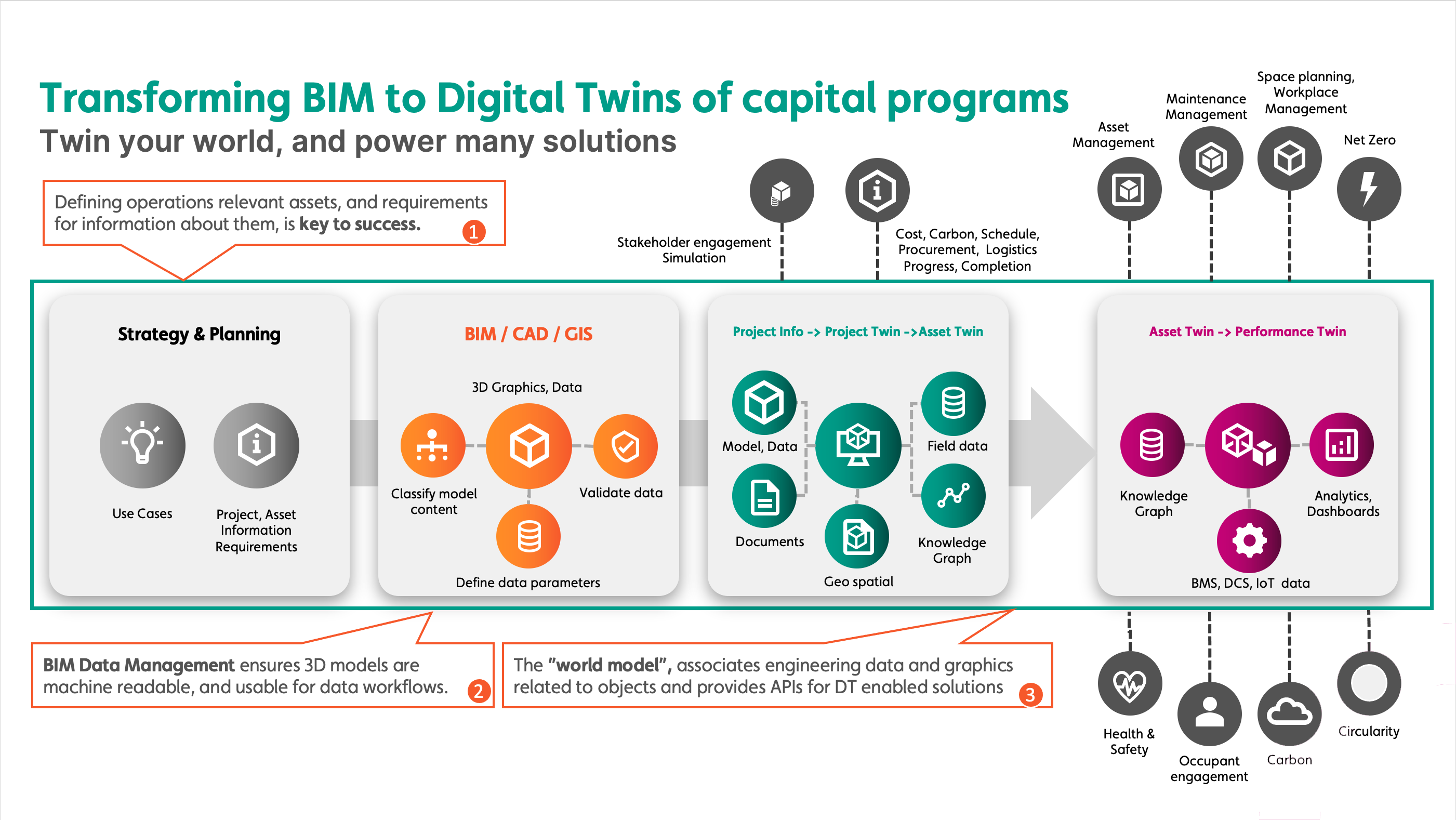Transforming building information models into Digital Twins for Operations: The journey and the tools

Chief Executive Officer, Co-Founder
Introduction
The evolution of the construction industry in the digital age has centred significantly on the application of Building Information Modelling (BIM) for design and construction. This article delves into how Invicara plays an instrumental role in leveraging BIM beyond design and construction, and making it a cornerstone for driving efficiency in asset operations. The concepts described in this article apply equally to buildings, and to infrastructure assets.
The Evolution of BIM
The maturity of BIM has unfolded progressively over time, moving from a fledgeling technology to an indispensable process in the AEC sector. Over the last decade, BIM practitioners have made sustained progress to manage the change from 2D drafting to the generation of construction documents from co-ordinated 3D digital models. This maturation has facilitated the creation of significant value in design and construction. This has resulted in improved collaboration, fewer errors, reduced costs, and shorter project timelines.
The Transition from Construction to Operations
The benefits of BIM do not end with the construction phase, although the utility of BIM tools that are used in design and construction do come to an end. At the point of handover, the information produced by the BIM process, can come together to create an Asset Twin.
But for this to happen, very specific data management workflows need to be implemented during design and construction. Models need to be classified consistently and accurately, data relating to various classes of objects must be defined, captured and validated. Digital Twins rely on good data, not just 3D graphics. Invicara has developed BIM Classify and BIM Assure to streamline the data management process which involves all members of the design and construction team.
What is an Asset Twin
The Asset Twin is the first stage of Digital Twin development. It is akin to an online digital manual of the physical asset. It serves as the system of record for all information that will be required by the asset operator to maintain and manage the asset over its entire life. The Asset Twin is a living repository that gets progressively updated with changes and new information generated when the asset is in operation.
It contains as built information which comprises of graphics and data from 3D models, warranty, testing and commissioning data related to maintainable equipment, and documents relating safety, operations and maintenance. This information will change over time when equipment get replaced and space layouts get altered to meet changing needs. It will also contain new information such as inspection reports, service reports, maintenance history and costs.
Benefits of an Asset Twin
An Asset Twin streamlines Digital handover from construction to operations
- Democratises information and provides seamless data access to authorised users.
- Enables real time updates of a system of record, delivering a single source of truth for asset information.
- Enables consistent and efficient onboarding and training of personnel, ensures continuity.
- Integrates with in-house or supplier systems for asset and maintenance. management.
- Supports capital planning and makes the facility smart ready.
The Crucial Role of Information Managers
This role provides stewardship to BIM data management and is pivotal in the definition, governance, production, validation and transitioning of data from BIM into an Asset Twin at project handover. The IM ensures that the data requirements for handover is meaningful and useful for the operations teams, and ensures the implementation of a strategy and delivery plan to achieve a successful outcome.

Who plays the IM role on a project?
It depends. In most cases it would be a representative appointed by the client / developer someone who manages the information exchange process, such as a BIM consultant or a Project Manager. Many Architecture, Engineering, and Project Management firms offer this service. Alternatively, if the deliverables are set our clearly, the General Contractor may take this role and orchestrate the production, validation and delivery of data from their supply chain, while also taking responsibility to produce and deliver an Asset Twin using a customisable template from Invicara, which is available on the Twinit Marketplace.
The 1CAT (One click Asset Twin) tool chain from Invicara provides the IM a very mature environment to manage the related workflows with relative ease.
Smart and Sustainable Assets
Developers, Occupiers and Operators of buildings and infrastructure have an increasing need to achieve high performance buildings that deliver comfort & wellness to occupants, progressively diminish and optimise use of energy and water, and reduce cost of operations while maintaining high service levels.
The Asset Twin serves as the perfect foundation for a MSI (Master systems integrator) to create a Performance Twin, to manage smart and sustainable buildings or infrastructure.
A Performance Twin delivers many benefits
- By integrating data from the BMS and IoT sensors and meters in the building, it provides all information on a single pane of glass and provides contextual visualisations.
- The knowledge graph powers AI and analytics for anomaly detection, and notification leading to proactive/ predictive interventions and issue resolution, thereby reducing down times, repair costs and increasing asset life.
- By integrating occupancy, air quality and energy analytics, a performance twin can provide unprecedented insights to help optimise comfort, wellness and energy use.
- Streamlines reporting into corporate ESG systems, and supports risk audits.
- Such a Performance Twin will progressively enable cognitive and autonomous facilities of the future.
The Need for Composable Twins
Recognising that one size doesn't fit all, and requirements vary significantly based on the asset type, its business model and operations plan, Invicara has built templates for creating Asset Twins and Performance Twins, rather than a "product" with fixed schemas, workflows and user interfaces. These templates have been composed on the Twinit platform, and can therefore be recomposed by the IM or the MSI as needed.
Conclusion
The opportunity, technology and tools are now very mature for practioners to leverage BIM to create and deliver Digital Twin solutions to support asset operations. This will expand the economy by enabling new business models for domain experts to consult and deliver digital services to help asset occupiers and operators to achieve high performance buildings.

Talk to us to know how composable twins can power your business
Contact us

